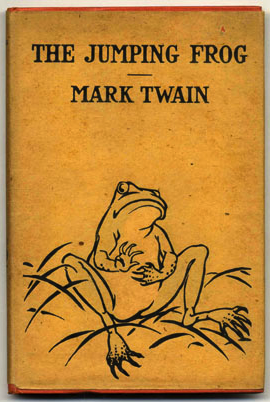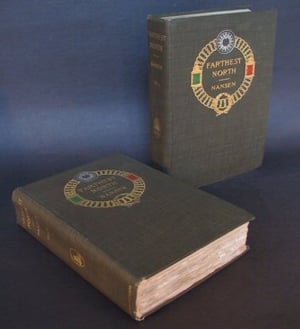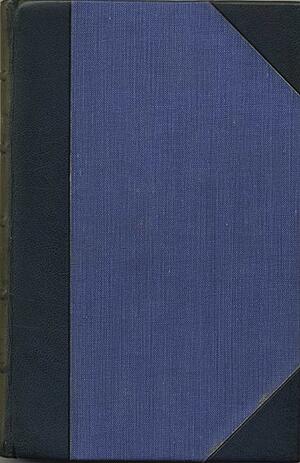For anyone interested in book collecting, understanding the terminology used in the book buying and selling industry is essential. When it comes to a book’s binding, there are many descriptors that are used. Do you know the difference between half bound and quarter bound? What does it mean if a book’s been shaken? Can you describe the difference between Octavo and Quarto? Let us help with this glossary of book binding terms.
 Boards – The stiff material commonly referred to as the covers. Boards were historically made of wood, but most modern binders use cardboard.
Boards – The stiff material commonly referred to as the covers. Boards were historically made of wood, but most modern binders use cardboard.
Bowed – A condition where the boards of a hardcover book have turned either inwards or outwards in relation to the leaves. This often occurs because of a rapid change in moisture.
Cocked – Spine cocked refers to book that is twisted in a way that the front and back boards don't line up when the book is laying flat. Shelf cocked refers to a book that cannot stand perpendicular to the shelf (also called a spine lean).
Dos-à-dos – In dos-à-dos binding (from the French for "back-to-back"), two books are bound back-to-back so that they share one lower board as back cover and open in opposite directions. This binding form was popular from the 17th century onward. The proper terminology for this type of binding is tête-bêche (from the French for head-to-toe), but dos-à-dos binding is used more loosely as an over-arching term for this type of binding.
Dust Jacket - The (mostly) paper jacket which is wrapped around most modern books to protect the cloth covers. Sometimes (often in the United Kingdom) called a dust wrapper, it often includes information about the book and author. The earliest recorded dust jackets date from the early nineteenth century. (The dust jacket pictured above from Mark Twain's The Jumping Frog is from 1903.)
End Papers – Double leaves bound in at the front and rear of a book after printing. One leaf is pasted to the board, with the other remaining free. Usually, the end papers are blank, and thus they make an ideal location for an author's signature.
Flyleaf – The extra blank page (leaf) after the end papers.
Folio – Multiple pages of text (two to a side, four total) printed on a full sheet of paper that is then folded only once to produce two leaves, or four pages. May also be abbreviated with: fo or 2°. Folio is also used to describe the general size of a book if it’s about 15 inches.
Full Bound – a binding style in which the book is bound in one material (leather, cloth, etc.).
Joint and Hinge – The joint is the exterior element where a board joins the spine and bends when opened. The interior side is the hinge, which can be covered in endpapers.
 Half bound – a binding style in which the spine and a small portion of the sides or the corners of a book are bound in one material and the sides are covered in a different material.
Half bound – a binding style in which the spine and a small portion of the sides or the corners of a book are bound in one material and the sides are covered in a different material.
Head – The aptly named top edge of the book.
Headband – A decorative band, usually colored, which originally protected the top and bottom edges of the spine but in modern books is strictly decorative. The band can be plain or colored, and was originally worked over leather, cord, or rolled paper.
Leaf – A single sheet of paper or parchment that comprises one page on the front side (recto) and another on the back (verso).
Octavo - Multiple pages of text (eight to a side, sixteen total) printed on a full sheet of paper that is then folded three times to produce eight leaves, or sixteen pages, after cutting the seams. May also be abbreviated with: 8vo, 8°, or In-8. The name octavo comes from the fact that each leaf is about 1/8 the size of the original full sheet.
Paste-Down – Part of the end papers that are glued to the inner boards of a hardback book and extend to coat the inside edge of the books binding. The paste-down is crucial to maintaining the structure of the book, as it forms part of the hinge.
Quarter bound – a binding style in which the spine and a small portion of the sides of a book are bound in one material and the sides are covered in a different material. Note: the corners of a book are not bound in the same material as the spine, thus differentiating quarter binding from half binding.
 Quarto – Multiple pages of text (four to a side, eight total) printed on a full sheet of paper that is then folded twice to produce four leaves, or eight pages, after cutting the seams. May also be abbreviated with: Qto, 4to or 4°. The name quarto comes from the fact that each leaf is about 1/4 the size of the original full sheet.
Quarto – Multiple pages of text (four to a side, eight total) printed on a full sheet of paper that is then folded twice to produce four leaves, or eight pages, after cutting the seams. May also be abbreviated with: Qto, 4to or 4°. The name quarto comes from the fact that each leaf is about 1/4 the size of the original full sheet.
Shaken – Used to describe a book whose pages have become loose in their binding; no longer tight, but not detached.
Starting Hinge – Sometimes referred to as a "cracked hinge", a starting hinge refers to an instance where the cover still attached at the hinge, but the endpaper is beginning to split.
Tail/Foot – The aptly named bottom edge of the book.
Three-Quarter Bound – a binding style in which the spine and the majority of the sides of a book are bound in one material and a second material covers the remaining sides; also used when the spine and a large portion of the corners are bound in the same material.
Tipped-In – A technique where pages, plates, or signatures are glued into the book post binding of the book.
Warped – Term used to describe a book or dust jacket that has become distorted or bent out of shape, often due to moisture, dryness, or improper care.








